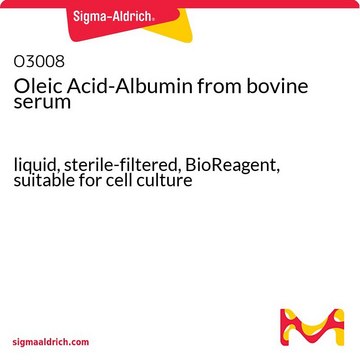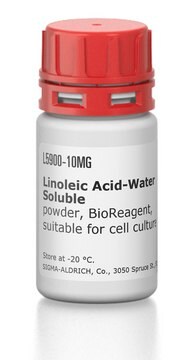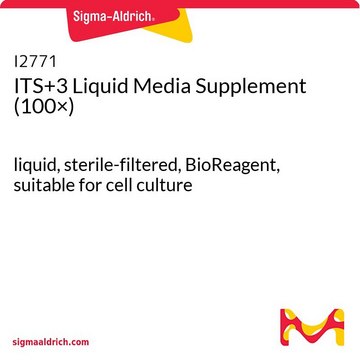L9655
Linoleic Acid-Oleic Acid-Albumin, 100x
liquid, sterile-filtered, BioReagent, suitable for cell culture
Sinónimos:
Fatty Acid-Albumin-complexes
About This Item
Productos recomendados
biological source
protein from bovine
sterility
sterile-filtered
product line
BioReagent
form
liquid
composition
linoleic acid and oleic acid, 2 mol/mol albumin (each)
concentration
100 mg/mL BSA in DPBS
technique(s)
cell culture | mammalian: suitable
impurities
endotoxin, tested
storage temp.
2-8°C
General description
Application
- to induce acute hepatocellular stress in primary hepatocytes
- to induce oxidative stress in cytotrophoblasts
- to induce lipid droplet accumulation in HepG2 cells
Related product
Storage Class
10 - Combustible liquids
wgk_germany
WGK 3
flash_point_f
Not applicable
flash_point_c
Not applicable
ppe
Eyeshields, Gloves
Elija entre una de las versiones más recientes:
¿Ya tiene este producto?
Encuentre la documentación para los productos que ha comprado recientemente en la Biblioteca de documentos.
Los clientes también vieron
Artículos
Importance and uses of linoleic acid in serum-free eukaryotic, including hybridoma and Chinese Hamster Ovary (CHO) cell, cultures
How the unsaturated fatty acid, oleic acid and other cell culture components affect the performance of serum-free, protein-free cell culture systems used for biomanufacturing heterologous proteins including monoclonal antibodies.
Nuestro equipo de científicos tiene experiencia en todas las áreas de investigación: Ciencias de la vida, Ciencia de los materiales, Síntesis química, Cromatografía, Analítica y muchas otras.
Póngase en contacto con el Servicio técnico











